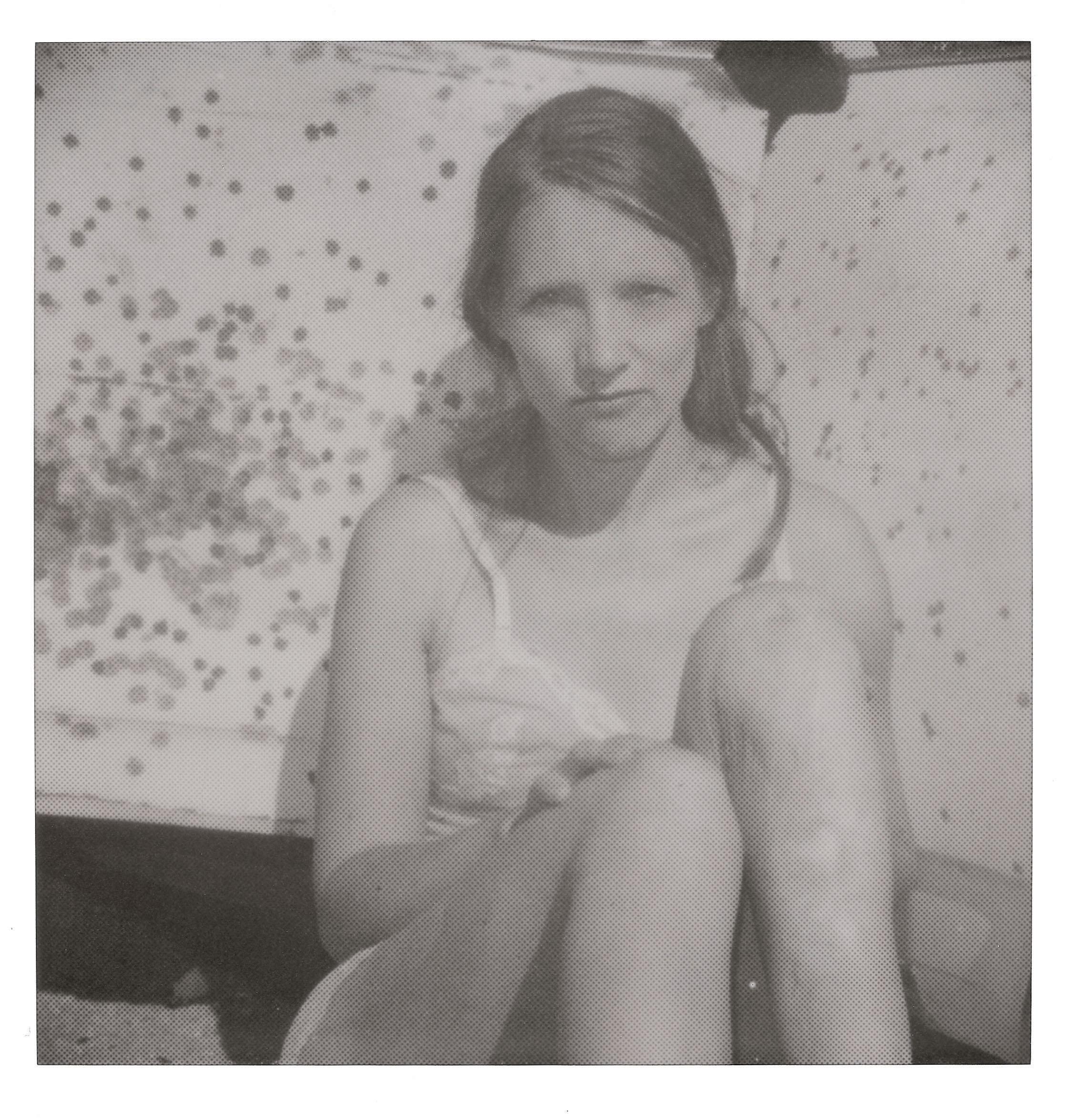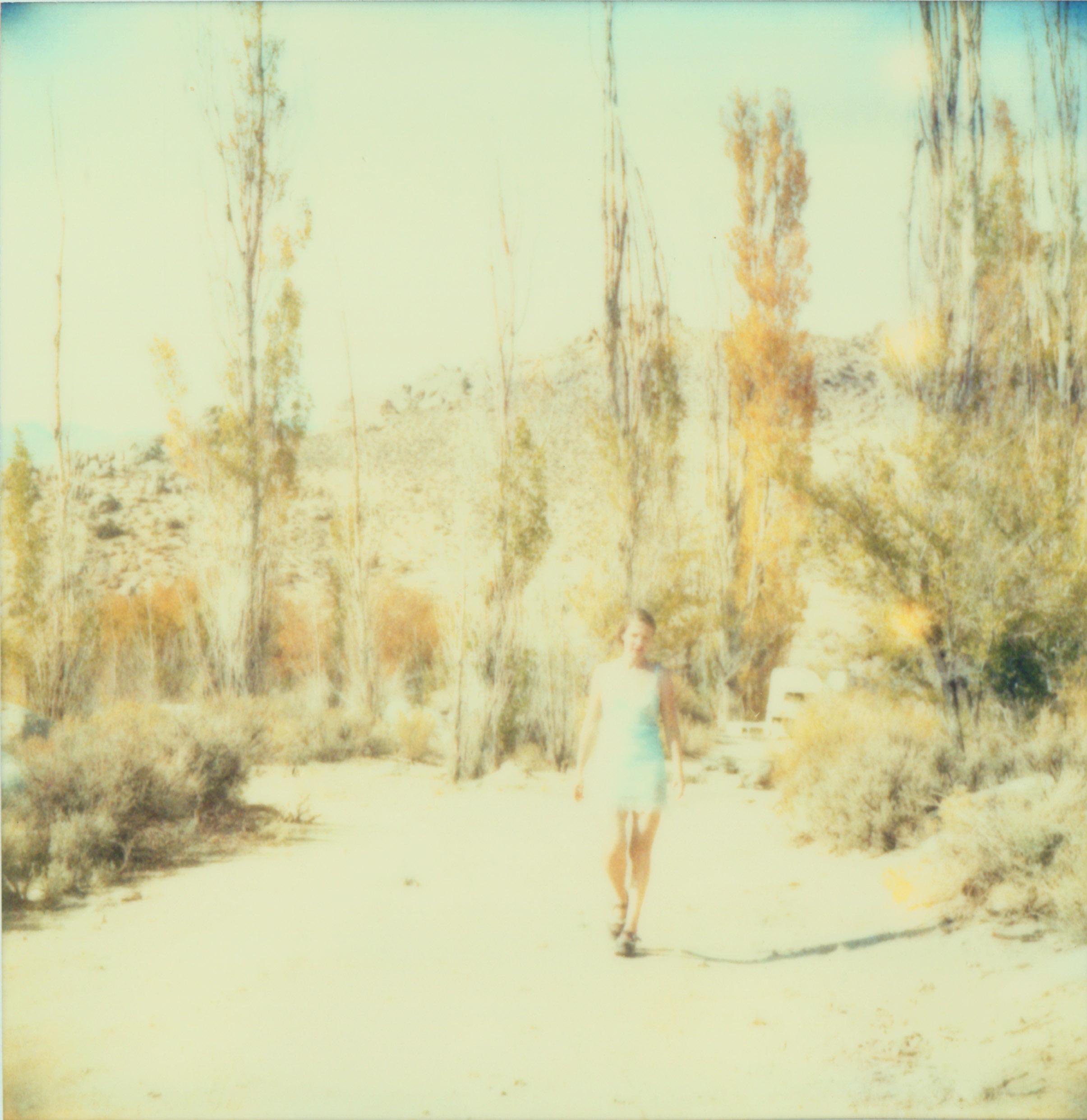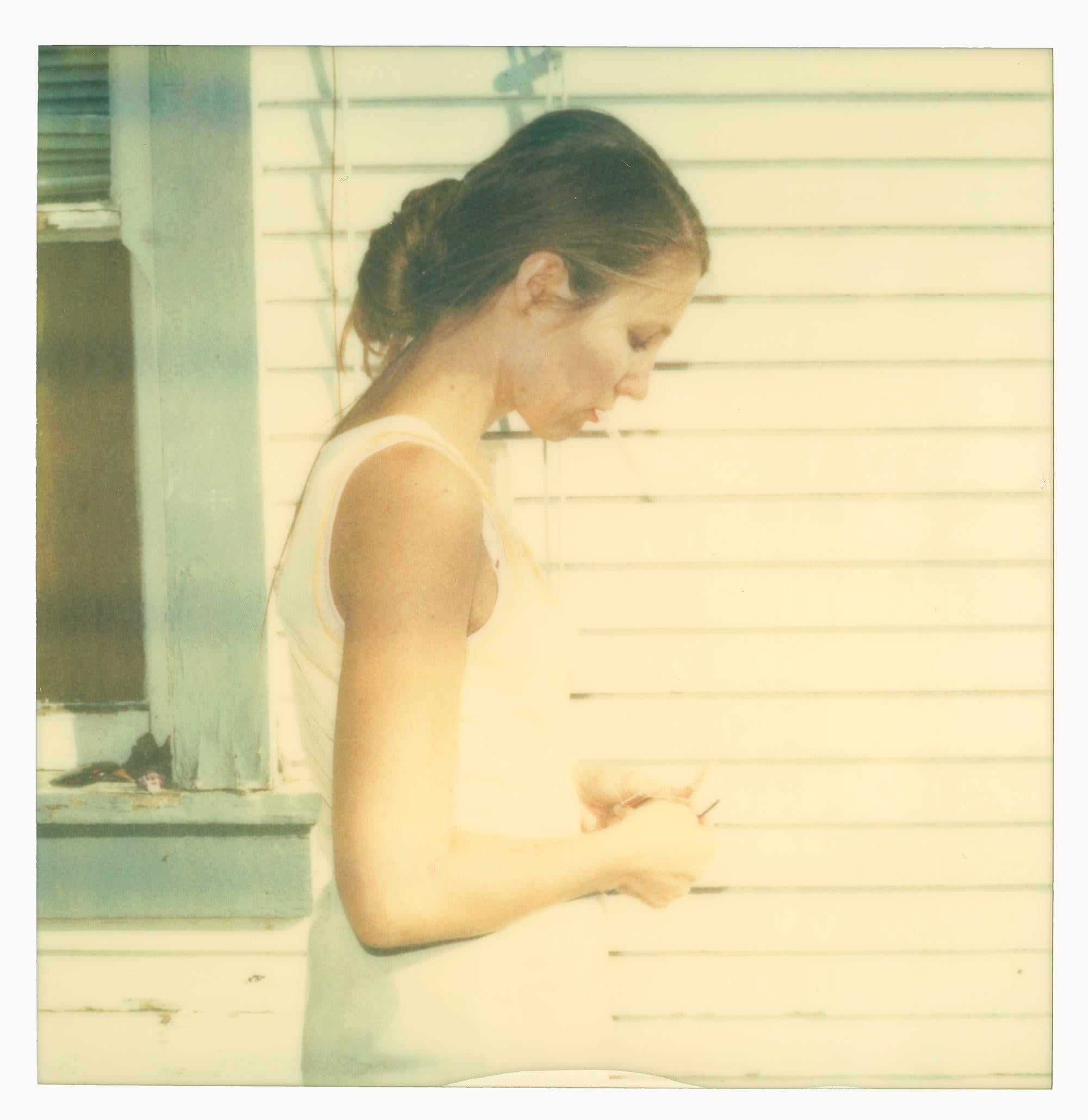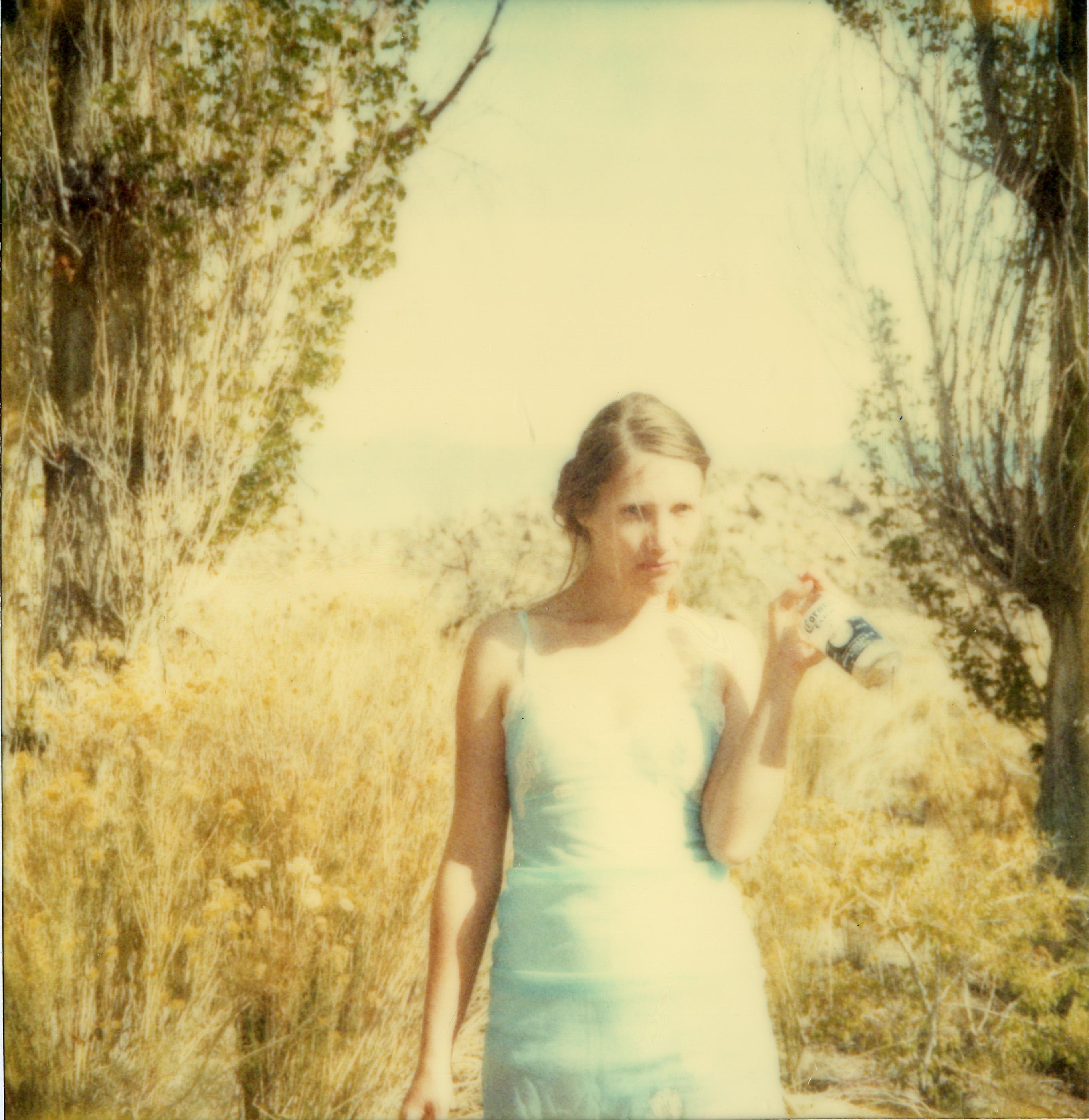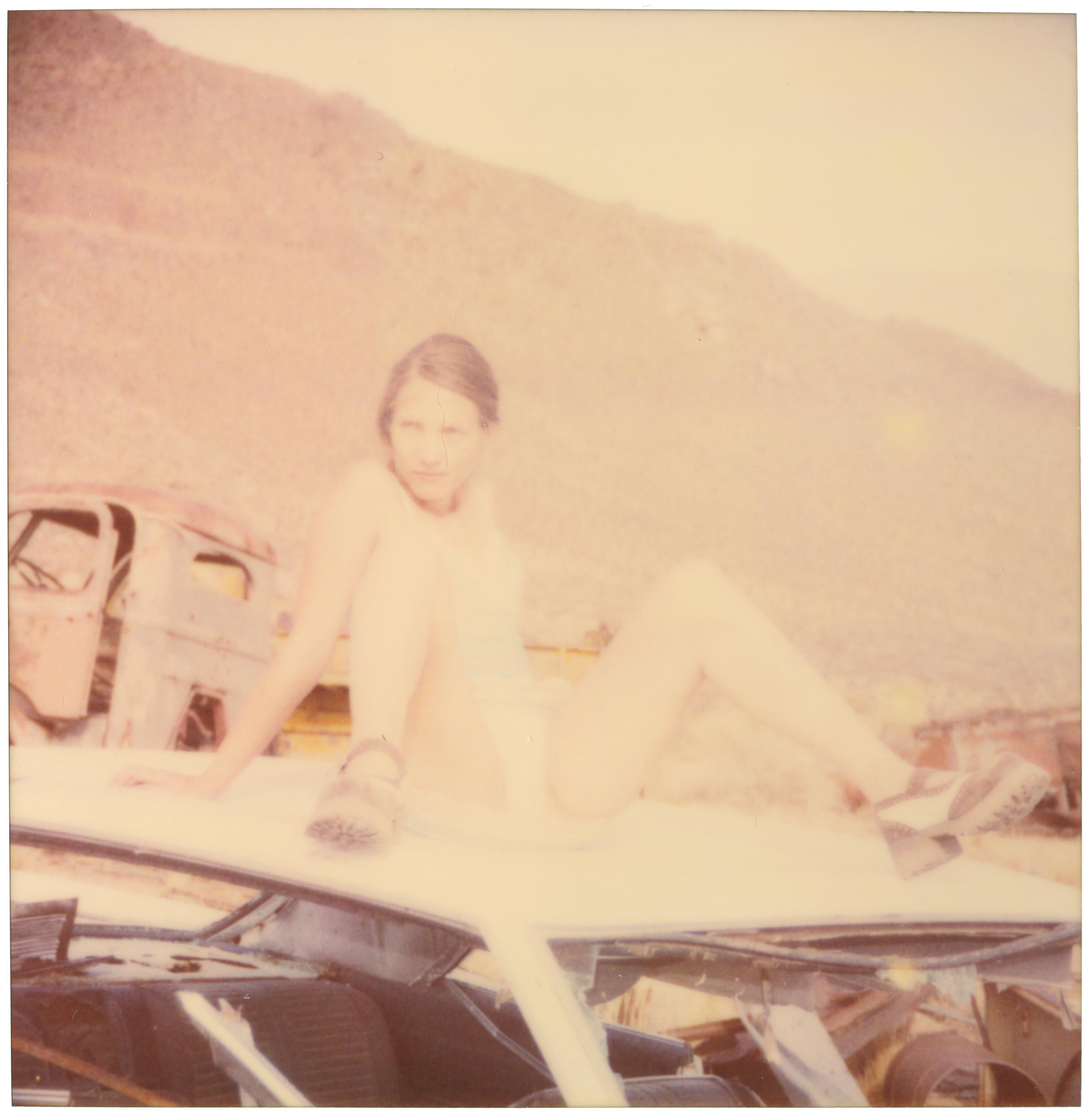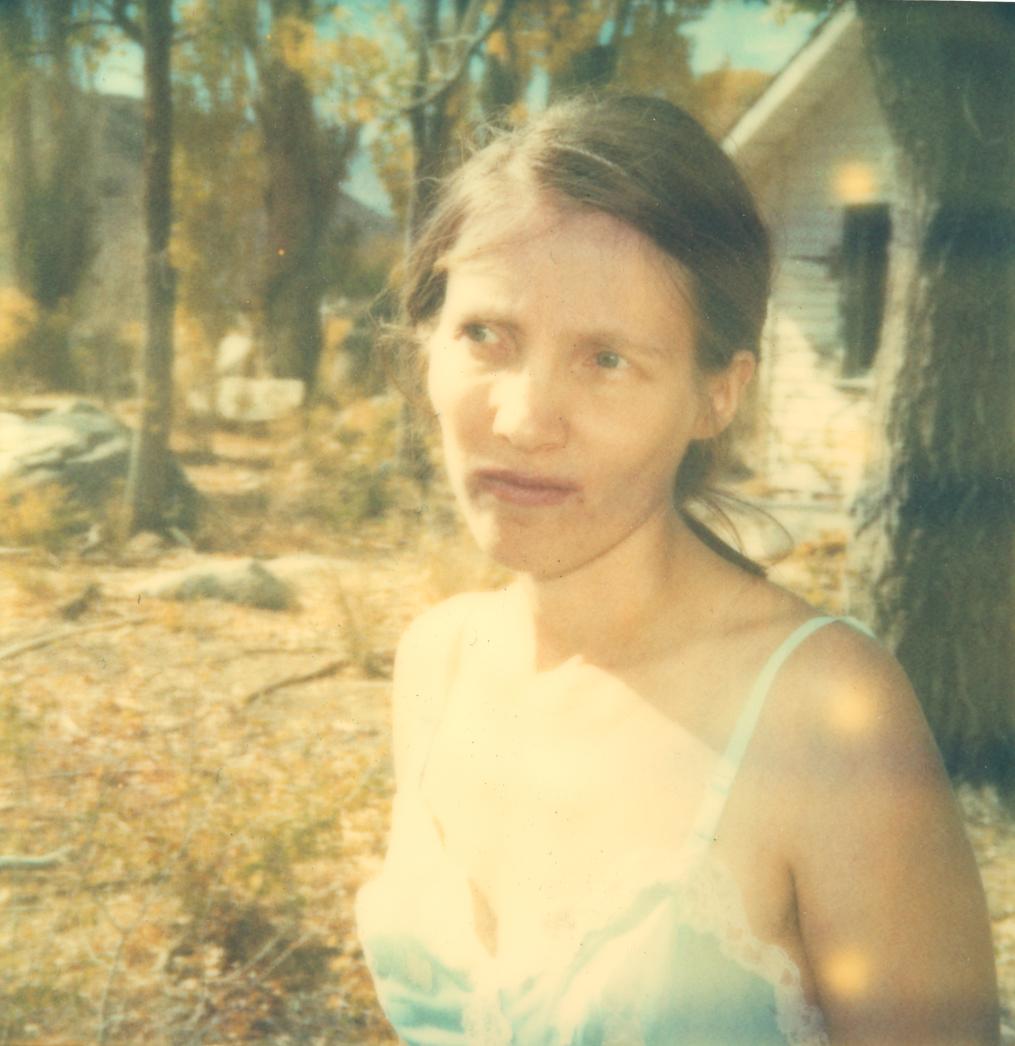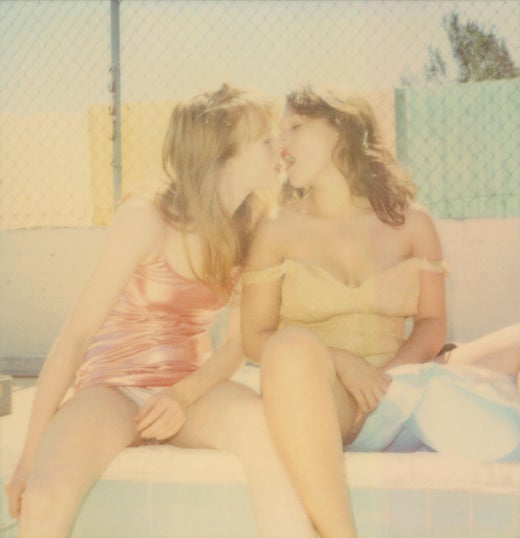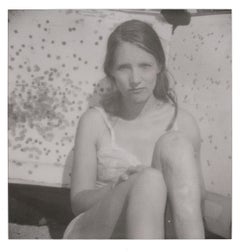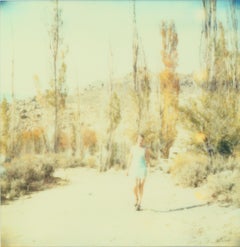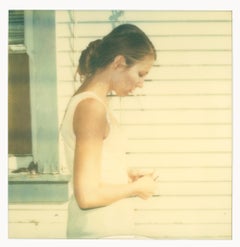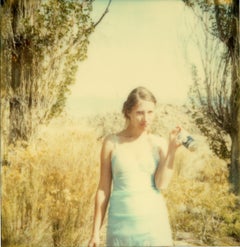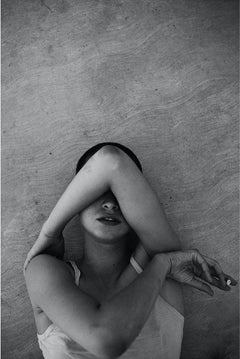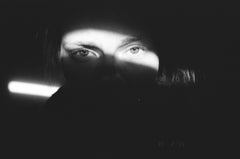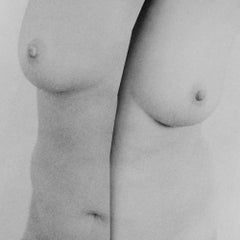Items Similar to Outtake (Wastelands)
Want more images or videos?
Request additional images or videos from the seller
1 of 2
Stefanie SchneiderOuttake (Wastelands)2003
2003
$380
£290.08
€333.46
CA$534.73
A$594.64
CHF 312.32
MX$7,270.07
NOK 3,891.78
SEK 3,668.89
DKK 2,488.71
About the Item
Outtake - (Wastelands) - 2003
20x20cm,
Edition of 10, plus 2 Artist Proofs.
Archival C-Print, based on the original Polaroid.
Artist inventory Number 819.
Signature label and certificate.
Not mounted.
For sale is a piece from the Wastelands series.
Published in: WASTELANDS, published by edition braus, Wachter Verlag, Heidelberg, 2006 (monograph)
Exhibited:
Wastelands, Städtische Galerie, Waldkraiburg, Germany (S) (2006) / Wastelands, Zephyr, Mannheim, Germany (S) (catalog) (2006) Wastelands, Kunstverein Recklinghausen, Germany (S) (2007), Stranger Than Paradise, Scott White Contemporary, San Diego, (S) (2012)
Reality with the Tequila:
Stefanie Schneider’s Fertile Wasteland
by James Scarborough
“How much more than enough
for you for I for both of us darling?”
(E. E. Cummings)
Until he met her, his destiny was his own. Petty and inconsequential but still his own. He was cocksure and free, young and unaccountable, with dark hair and aquiline features. His expression was always pensive, a little troubled, but not of a maniacal sort. He was more bored than anything else. With a heart capable of violence.
Until she met him, she was pretty but unappreciated. Her soul had registered no seismic activity. Dust bowl weary, she’d yet to see better days. A languorous body, a sweet face with eyes that could be kind if so inclined.
Until she met him, she had not been inclined.
It began when he met her. She was struck in an instant by his ennui. The sum of their meeting was greater than the imbroglios and chicaneries of their respective existences. He was struck by the blank slate look in her eyes. They walked, detached and focused on the immediate, obscenely unaware of pending change across a terrain of mountainous desert, their eyes downcast and world-weary, unable to account for the buoyant feeling in her heart. His hard-guy shtick went from potentiality to ruse. The gun was not a weapon but a prop, a way to pass time. Neither saw the dark clouds massing on the horizon.
They found themselves alone in the expanses of time, unaware of the calamity that percolated even as they posed like school kids for the pictures. Happiness brimmed in that wild terrain. Maybe things were beginning to look up.
That’s when the shooting started…
Stefanie Schneider assumes that our experience of lived reality (buying groceries, having a relationship with someone, driving a car) does not correspond to the actual nature of lived reality itself, that what we think of as reality is more like a margarita without the tequila.
Stefanie Schneider’s reality is reality with the tequila. She does not abolish concepts that orient us, cause and effect, time, plot, and story line, she just plays with them. She invites us to play with them, too. She offers us a hybrid reality, more amorphous than that with a conventional subject, verb, and predicate. Open ended, this hybrid reality does not resolve itself. It frustrates anyone with pedestrian expectations but once we inebriate those expectations away, her work exhilarates us and even the hangover is good. An exploration of how she undermines our expectation of what we assume to be our lived reality, the reasons why she undermines our expectations, and the end-result, as posited in this book, will show how she bursts open our apparatus of perception and acknowledges life’s fluidity, its density, its complexity. Its beauty.
She undermines expectations of our experience of reality with odd, other worldly images and with startling and unexpected compressions and expansions of time and narrative sequence. The landscape seems familiar enough, scenes from the Old West: broad panoramic vistas with rolling hills dotted with trees and chaparral, dusty prairies with trees and shrubs and craggy rocks, close-up shots of trees. But they’re not familiar. These mis en-scenes radiate an unsettling Picasso Blue Period glow or the intense celestial blue of the cafe skies that Van Gogh painted in the south of France. Yellow starbursts punctuate images as if seen through the viewfinder of a flying saucer. At the same time, objects appear both vintage and futuristic, the landscape of a post apocalyptic world.
Landscapes change seemingly at random as do the seasons. Stefanie Schneider offers no indication of how time flows here, except that it conceivably turns in on itself and then goes its merry way. Time is a river whose source is a deep murky spring which blusters about with an occasional swirling eddy.
That Stefanie Schneider thwarts an easy reading is obvious but why does she do this? Since she will not countenance anything linear, logical, or sequential, and because she does not relish anything concrete and specific, she has to roil things up a bit. Nor does she seem comfortable with a book of images that is settled, discrete, and accountable. Instead she wants to create a panoply of anxious moments that refuse to settle down into any predetermined reading. She seeks to assemble the elements, establish a provisional cosmology and then let each of us bring our own life experiences to bear on the enterprise. She unravels the paucity of a universe compromised by a matrix of either/or and replaces it with a kaleidoscopic neither/both cornucopia.
No fan of Descartes, she does not adhere to anything predicated on cogito ergo sum. No, the chance to present a universe of limitless iterations and utterances, open-ended, casualty thwarting, intrigues her. She broaches a Heraclitan world: she shows that attempts to master, manage, and hoard time prove to be as elusive as a blind man trying to grab a salmon barehanded from a cold mountain stream. Even within the clear cut parameters of the Old West universe onto which she gloms, she shows that time is a bandit, that it is a mirage, that it is as unpredictable as it is indefinable and infinite. She coaxes us, scene by scene a slow motion, out of sequence film clip, to agree with her that a running moat of lived reality easily overwhelms a castle of rationality.
Stefanie Schneider does not mount a demolition effort much less a deconstruction one. Rather, she dismantles our expectations and sets about rebuilding not things but their connections anew. She is the mistress of the synapses. Indeed all these annoying ambiguities and irritating ambiances set the stage for a very particular certainty, one kernel of truth amidst these skewed and open ended fields of inquiry. What connects all these images, in whatever order they might be presented1, is what I call an Augenblick, the mental distance between each page in whose expanse occurs the processing of shards of lived experience between these blinks of an eye that comprise the pages of Wastelands. During these innumerous Augenblicke, we take whatever shifts and turns that Stefanie Schneider throws at us, recalibrate our bearings, and then move on, at least until the next inevitable obstruction.
Irritating (and enlightening) as these shots may be, they’re nothing new. Rilke writes that, instead of trying to understand the quiddities of things, we should just be joyous at their mystery, just assume that they’re written in a lovely script that neither you nor anyone else can ever understand. Keats writes about being “awake forever in a sweet unrest,” although he’s talking about love. Stefanie Schneider makes us work for this idea of an Augenblick, but the result is worth it. The scenes and their sequencing dazzle us in a Borgesian Hall of Mirrors. Stefanie Schneider shows us that reality is anything but linear and user friendly, but once one becomes accustomed to her enhanced dimension of space and time, we see the world in all its multifarious beauty and rapture. For that reason, Stefanie Schneider’s Augenblicke show us that reality may be a wasteland but it is as fertile as fertile can be.
1 I refer to Julio Cortazar’s novel, Hopscotch, in which he presents his story in a linear
way, with consecutive chapters that follow a particular coherence. In a note at the be-
ginning of the novel, he suggests an alternative reading via a new sequence of chapters.
So instead of reading chapter 1 first, chapter 2 second, you read, say chapter 57 first,
chapter 32 second, chapter 1 third and so on to form a new story. Similarly, Stefanie
Schneider’s Wastelands offers a multitude of coherences.
- Creator:Stefanie Schneider (1968, German)
- Creation Year:2003
- Dimensions:Height: 7.88 in (20 cm)Width: 7.88 in (20 cm)Depth: 0.04 in (1 mm)
- Medium:
- Movement & Style:
- Period:
- Condition:
- Gallery Location:Morongo Valley, CA
- Reference Number:1stDibs: LU652314549312
Stefanie Schneider
Stefanie Schneider received her MFA in Communication Design at the Folkwang Schule Essen, Germany. Her work has been shown at the Museum for Photography, Braunschweig, Museum für Kommunikation, Berlin, the Institut für Neue Medien, Frankfurt, the Nassauischer Kunstverein, Wiesbaden, Kunstverein Bielefeld, Museum für Moderne Kunst Passau, Les Rencontres d'Arles, Foto -Triennale Esslingen., Bombay Beach Biennale 2018, 2019.
About the Seller
4.9
Platinum Seller
Premium sellers with a 4.7+ rating and 24-hour response times
Established in 1996
1stDibs seller since 2017
1,037 sales on 1stDibs
Typical response time: 2 hours
- ShippingRetrieving quote...Shipping from: Morongo Valley, CA
- Return Policy
Authenticity Guarantee
In the unlikely event there’s an issue with an item’s authenticity, contact us within 1 year for a full refund. DetailsMoney-Back Guarantee
If your item is not as described, is damaged in transit, or does not arrive, contact us within 7 days for a full refund. Details24-Hour Cancellation
You have a 24-hour grace period in which to reconsider your purchase, with no questions asked.Vetted Professional Sellers
Our world-class sellers must adhere to strict standards for service and quality, maintaining the integrity of our listings.Price-Match Guarantee
If you find that a seller listed the same item for a lower price elsewhere, we’ll match it.Trusted Global Delivery
Our best-in-class carrier network provides specialized shipping options worldwide, including custom delivery.More From This Seller
View AllOuttake (Wastelands) - Polaroid, Contemporary, 21st Century, Analog, mounted
By Stefanie Schneider
Located in Morongo Valley, CA
Outtake (Wastelands) - 2003
Edition of 5,
128x125cm,
analog C-Print, hand-printed by the artist on Fuji Crystal Archive Paper,
based on the Polaroid,
Artist inventory Number 819.01,
complete with certificate and signature label
Not mounted
For sale is a piece from the Wastelands series. purchase the 2nd edition and have it unmounted.
Exhibited:
Wastelands, Städtische Galerie, Waldkraiburg, Germany (S) (2006) / Wastelands, Zephyr, Mannheim, Germany (S) (catalog) (2006) Wastelands, Kunstverein Recklinghausen, Germany (S) (2007)
Published in: WASTELANDS published by edition braus, Wachter Verlag, Heidelberg, 2006 (monograph)
Reality with the Tequila:
Stefanie Schneider’s Fertile Wasteland
by James Scarborough
“How much more than enough
for you for I for both of us darling?”
(E. E. Cummings)
Until he met her, his destiny was his own. Petty and inconsequential but still his own. He was cocksure and free, young and unaccountable, with dark hair and aquiline features. His expression was always pensive, a little troubled, but not of a maniacal sort. He was more bored than anything else. With a heart capable of violence.
Until she met him, she was pretty but unappreciated. Her soul had regis- tered no seismic activity. Dust bowl weary, she’d yet to see better days. A languorous body, a sweet face with eyes that could be kind if so inclined.
Until she met him, she had not been inclined.
It began when he met her. She was struck in an instant by his ennui. The sum of their meeting was greater than the imbroglios and chicaneries of their respective existences. He was struck by the blank slate look in her eyes. They walked, detached and focused on the immediate, obscenely unaware of pending change across a terrain of mountainous desert, their eyes downcast and world-weary, unable to account for the buoyant feeling in her heart. His hard-guy shtick went from potentiality to ruse. The gun was not a weapon but a prop, a way to pass time. Neither saw the dark clouds massing on the horizon.
They found themselves alone in the expanses of time, unaware of the calamity that percolated even as they posed like school kids for the pic- tures. Happiness brimmed in that wild terrain. Maybe things were begin- ning to look up.
That’s when the shooting started…
Stefanie Schneider assumes that our experience of lived reality (buying groceries, having a relationship with someone, driving a car) does not correspond to the actual nature of lived reality itself, that what we think of as reality is more like a margarita without the tequila.
Stefanie Schneider’s reality is reality with the tequila. She does not abol- ish concepts that orient us, cause and effect, time, plot, and story line, she just plays with them. She invites us to play with them, too. She offers us a hybrid reality, more amorphous than that with a conventional subject, verb, and predicate. Open-ended, this hybrid reality does not resolve itself. It frustrates anyone with pedestrian expectations but once we inebriate those expectations away, her work exhilarates us and even the hangover is good. An exploration of how she undermines our expectation of what we assume to be our lived reality, the reasons why she under- mines our expectations, and the end-result, as posited in this book, will show how she bursts open our apparatus of perception and acknowl- edges life’s fluidity, its density, its complexity. Its beauty.
She undermines expectations of our experience of reality with odd, other- worldly images and with startling and unexpected compressions and expansions of time and narrative sequence. The landscape seems familiar enough, scenes from the Old West: broad panoramic vistas with rolling hills dotted with trees and chaparral, dusty prairies with trees and shrubs and craggy rocks, close-up shots of trees. But they’re not familiar. These mis-en-scenes radiate an unsettling Picasso Blue Period...
Category
Early 2000s Contemporary Black and White Photography
Materials
Archival Paper, Photographic Paper, C Print, Color, Polaroid
Last Season II (Wastelands)
By Stefanie Schneider
Located in Morongo Valley, CA
Last Season II - so I walked away from my Valley (Wastelands) - 2003
20x20cm,
Edition of 10, plus 2 Artist Proofs.
Archival C-Print, based on the original Polaroid.
Artist invento...
Category
Early 2000s Contemporary Portrait Photography
Materials
Archival Paper, Photographic Paper, C Print, Color, Polaroid
Untitled (The Last Picture Show)
By Stefanie Schneider
Located in Morongo Valley, CA
'Untitled' (The Last Picture Show) - 2005
38x37cm,
Edition of 10.
Archival C-Print, based on the Polaroid.
Certificate and signature label.
Artist inventory 1016.
Not mounted.
Category
Early 2000s Contemporary Figurative Photography
Materials
Archival Paper, Photographic Paper, C Print, Color, Polaroid
Unbound (Wastelands) Contemporary, 21st Century, Polaroid, Portrait, Photograph
By Stefanie Schneider
Located in Morongo Valley, CA
Unbound (Wastelands) - 2003
Edition of 10,
38x36cm,
Archival C-Print on Crystal Fuji Archive paper, matte surface, based on the Polaroid.
Artist inventory Number 836.
Signature ...
Category
1990s Contemporary Portrait Photography
Materials
Archival Paper, Photographic Paper, C Print, Color, Polaroid
Waiting for Randy (Wastelands)
By Stefanie Schneider
Located in Morongo Valley, CA
Waiting for Randy (Wastelands) - 2003
38x37cm,
Edition of 10, plus 2 Artist Proofs.
Archival C-Print, based on the original Polaroid.
Artist inventory Number 1166.
Signature lab...
Category
Early 2000s Contemporary Color Photography
Materials
Archival Paper, Photographic Paper, C Print, Color, Polaroid
After (Wastelands) - Contemporary, Analog, Polaroid, Color
By Stefanie Schneider
Located in Morongo Valley, CA
After (Wastelands) - 2003
20x20cm,
Edition of 10 plus 2 Artist Proofs.
Archival C-Print, based on the original Polaroid.
Artist inventory Number 18799.
Signature label and Certi...
Category
Early 2000s Contemporary Color Photography
Materials
Archival Paper, Photographic Paper, C Print, Color, Polaroid
You May Also Like
Untitled (Nr. 0423) Black & White Photography 44" x 36" Ed. of 12 by Ben Cope
By Ben Cope
Located in Culver City, CA
Untitled (Nr. 0423) Black & White Photography 44" x 36" Ed. of 12 by Ben Cope
Unframed - ships rolled in a tube
Ben Cope + Rowan Daly Off the Grid
Off the Grid is the culminatio...
Category
21st Century and Contemporary Contemporary Portrait Prints
Materials
Archival Pigment
Untitled (Nr. 0423) Photography 24" x 18" Edition of 24 by Ben Cope
By Ben Cope
Located in Culver City, CA
Untitled (Nr. 0423) Photography 24" x 18" Edition of 24 by Ben Cope
Unframed - ships rolled in a tube
Ben Cope + Rowan Daly Off the Grid
Off the Grid is the culmination of a six...
Category
21st Century and Contemporary Contemporary Portrait Prints
Materials
Archival Pigment
Untitled (Calendar) – Lina Scheynius, Black and White, Photography, Woman, Light
By Lina Scheynius
Located in Zurich, CH
Lina Scheynius (*1981 Sweden)
Untitled (Calendar)
2013
Fibre-based silver gelatin print
Image 16 x 24 cm (6 1/4 x 9 1/2 in.)
Sheet 25 x 30 cm (9 7/8 x 11 3/4 in.)
Frame 31,1 x 36,2 c...
Category
2010s Contemporary Black and White Photography
Materials
Silver Gelatin
Not titled yet, from the series 'A Gaze of One's Own‘ – Brigitte Lustenberger
By Brigitte Lustenberger
Located in Zurich, CH
Brigitte LUSTENBERGER (*1969, Switzerland)
Not titled yet, from the series 'A Gaze of One's Own‘, 2021
Silver gelatin print on Baryta paper
Sheet 70 x 70 cm (27 1/2 x 27 1/2 in.)
Edition of 5, plus 2 AP; Edn. no. 1/5
print only
Born in Zurich, Switzerland, Brigitte studied at Zurich University and received her MA in Social and Photo History in 1996. In the following years she established herself as an fine art photographer. She moved to New York and received her MFA in Fine Art Photography and Related Media at Parsons The New School of Design in 2007. The main issues in her works lie in her interest in the study of the gaze, the interplay between absence and presence in a photographic image, and the fact that the reading of a photograph is most often triggered by a collective memory. She explores the media itself and its close connection to themes like decay, memory, death and transitoriness.
Brigitte Lustenberger has shown nationally and internationally in both solo and group shows. She had Solo Shows at the Museée de l’Elysée in Lausanne/Switzerland, at Walter Keller’s Scalo Gallery in Zurich and New York, at Le Maillon...
Category
2010s Contemporary Black and White Photography
Materials
Silver Gelatin
She Disappeared into Complete Silence (AD6329) - figurative landscape photograph
By Mona Kuhn
Located in San Francisco, CA
In the series 'She Disappeared into Complete Silence' (2014) Mona Kuhn takes a new direction into abstraction.
She turns to a highly austere and restrained reductionist geometry and distilled formal purity, connecting the interior to the exterior, the visible to the hidden. These reflections cause one to linger, as they merge to create a dynamic equilibrium of tension, spaces and rythms.
AD6329 (She Disappeared into Complete Silence)
60" x 45" / 152cm x 114cm
edition of 8 + 2AP
40" x 30" / 102cm x 76cm
edition of 8 + 2AP
limited edition photograph is printed under artist supervision and accompanied by signed artist certificate:
artist signature labels are 8x10 in size
signed, editioned, dated and titled by the artist, and stamped for authenticity
label
__________________
About the artist
Acclaimed for her contemporary depictions, Kuhn is considered a leading artist in the world of figurative discourse. Throughout a career spanning more than twenty years, the underlying theme of her work is her reflection on humanity’s longing for spiritual connection and solidarity. As she solidified her photographic style, Kuhn created a notable approach to the nude by developing friendships with her subjects, and employing a range of playful visual strategies that use natural light and minimalist settings to evoke a sublime sense of comfort between the human figure and its environment. Her work is natural, restful, and a reinterpretation of the nude in the canon of contemporary art.
For the past two decades, the Los-Angeles based artist's works have been shown steadily, revealing an astonishing consistency in technique, of subject and of purpose. In 2001, Kuhn’s photographs were first seen by an influential audience during the exhibition at Charles Cowles Gallery in Chelsea, New York. Kuhn’s distinct aesthetic has propelled her as one of the most collectible contemporary art photographers—her work is in private and public collections worldwide and she is represented by galleries across the United States, Europe and Asia.
Kuhn was born in São Paulo, Brazil, in 1969, of German descent. In 1989, Kuhn moved to the US and earned her BA from The Ohio State University, before furthering her studies at the San Francisco Art Institute. She is currently an independent scholar at The Getty Research Institute in Los Angeles. Occasionally, Mona teaches at UCLA and the Art Center College of Design in Pasadena.
Mona Kuhn’s first monograph, Photographs, was debuted by Steidl in 2004; followed by Evidence (2007), Native (2010), Bordeaux Series (2011), Private (2014), and She Disappeared into Complete Silence (2018/19). In addition, Stanley/Barker Editions published Kuhn's Bushes and Succulents (2018) with a debut at Musee Jeu de Paume in Paris in 2019. Thames & Hudson published a career retrospective titled Works. Kuhn's most recent publication Kings Road with Steidl accompanies a multi-dimensional museum exhibition in Germany and the US.
Mona Kuhn’s work is in private and public collections worldwide, including The J. Paul Getty Museum, the Los Angeles County Museum of Art, The Hammer Museum, the Perez Art Museum in Miami, the Museum of Fine Arts, Houston, and the Kiyosato Museum in Japan. Kuhn's work has been exhibited at The Louvre Museum and Le Bal in Paris, The Whitechapel Gallery and Royal Academy of Arts in London, Musée de l’Elysée in Switzerland, Leopold Museum in Vienna Austria, The Polygon Gallery in Vancouver Canada, Australian Centre for Photography and Taipei Fine Arts Museum in Taiwan.
Mona Kuhn currently lives and works in Los Angeles.
__________________
Solo Exhibitions
2024
Mona Kuhn: Between Modernism and Surrealism, Houk Gallery, New York, NY
2023
Mona Kuhn: Kings Road, Galerie XII, Paris, France
Mona Kuhn: Kings Road, Kunsthaus-Göttingen, Germany
Mona Kuhn: Kings Road, Jackson Fine Art...
Category
21st Century and Contemporary Contemporary Black and White Photography
Materials
Photographic Film, Photographic Paper, Silver Gelatin
Not titled yet, from the series 'A Gaze of One's Own‘ – Brigitte Lustenberger
By Brigitte Lustenberger
Located in Zurich, CH
Brigitte LUSTENBERGER (*1969, Switzerland)
Not titled yet, from the series 'A Gaze of One's Own‘, 2021
Silver gelatin print on Baryta paper
Sheet 70 x 63 cm (27 1/2 x 24 3/4 in.)
Edi...
Category
2010s Contemporary Black and White Photography
Materials
Silver Gelatin
More Ways To Browse
Bowl Yellow Black
Cloud Bowl
West German Bowl
1920s Vogue
Black And White Woodstock
Porsche Print
Nicole Kidman
Martha Graham Print
Used Mailboxes
Bardot Poster
Brigitte Bardot Poster
Tyra Banks
Andy Warhol John Lennon
Black And White Photography Montreal
James Michener
Jim Holland
Muhammad Ali Photograph
Vogue 1939
